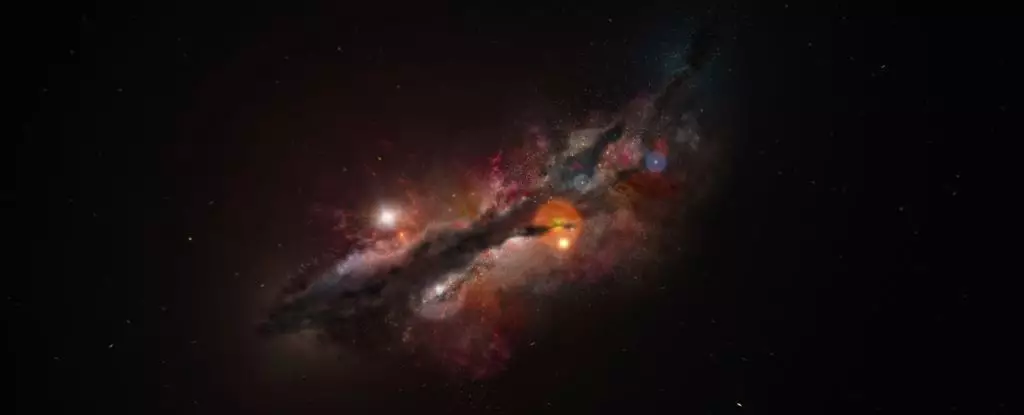In a revelation that has sent ripples through the astronomical community, a galaxy known as JADES-GS-z14-0 has been detected, flourishing in a period previously thought to lack the elements necessary for its existence. This galaxy, shining brightly just 300 million years after the Big Bang, presents a significant challenge to established cosmological theories, particularly concerning the evolution and formation of galaxies in the early Universe. Traditional models have long suggested that galaxies could not evolve and mature quickly enough to produce detectable quantities of oxygen and other heavier elements so soon after the big bang. However, this startling new evidence suggests that our understanding of the cosmos and its inception may need a dramatic overhaul.
The Implication of Oxygen
The presence of oxygen in JADES-GS-z14-0 is a seismic revelation. Scientists assumed that significant quantities of elements heavier than hydrogen and helium would not be prevalent until much later in the cosmic timeline, mainly because heavier elements are forged in the nuclear furnaces of stars. These massive stars burn brightly for up to ten million years before they explode in spectacular supernovae, dispersing these newly forged elements into the surrounding cosmos. The fact that JADES-GS-z14-0 has been found harboring oxygen—ten times more than researchers predicted—is a sign that this galaxy is much older in terms of elemental maturity than previously believed. This discovery raises vital questions about the processes that govern galaxy evolution and the timeline during which they took place.
Redefining Cosmic Maturity
As cosmologist Sander Schouws poignantly articulated, discovering a galaxy that appears “adolescent where you would only expect babies” implies a more rapid development of galaxies than science had assumed. Instead of a gradual assembly of stars and elements over billions of years, evidence suggests a timeline where galaxies in the primitive Universe were maturing at a staggering pace. The astronomers’ findings indicate that JADES-GS-z14-0 was not just a passive participant in the cosmic lineage, but an active engine of stellar and elemental development, challenging the entrenched beliefs in galaxy formation.
This development has possibly game-changing implications for our understanding of the Universe’s infancy. With the advent of powerful observational tools like the James Webb Space Telescope (JWST), we are starting to piece together a more intricate narrative about our Universe. The galaxies we are observing are not mere remnants of an early Universe slowly evolving; they are vigorous, bustling regions of star formation, bursting with life and complexity far earlier than our cosmological models anticipated.
A Paradigm Shift in Cosmic Understanding
The unexpected detection of oxygen in JADES-GS-z14-0 not only highlights the rapid cosmic evolution but also signifies a potential shift in the paradigm that governs how we interpret the formation of galaxies. “The evidence that a galaxy already appears mature in the infant Universe raises questions about when and how galaxies formed,” emphasizes astrophysicist Stefano Carniani. This is a clarion call for scientists to re-evaluate everything we thought we knew about galaxy formation. Are we underestimating the capabilities of primordial stars, or have we yet to comprehend the dynamics of the early Universe fundamentally?
The implications of observing such mature galaxies at such a significant distance push us to ponder the fundamental natures of time and space. Would future discoveries validate this newfound timeline or push it further back? Astronomers are not merely expanding our arsenal of knowledge but constantly challenging the boundaries of what we deem possible in cosmic history. The astronomical community must confront the prospect that our current understanding may simply be the tip of the cosmological iceberg.
The Fast-Track to Cosmic Maturity
Equipped with cutting-edge instruments such as the Atacama Large Millimeter/submillimeter Array in Chile, astronomers are unlocking the secrets of the celestial world, revealing galaxies that shine brightly earlier than we ever thought plausible. The rapid emergence of these galaxies and their hefty oxygen content signal a broader and perhaps more frantic chapter of cosmic history. As we continue to probe the depths of the Universe, we gain insight into processes that might have catalyzed such rapid galactic formation and the role of dark matter and energy during these primordial epochs.
As we digest the weight of these discoveries, one must ponder: What comes next? Will future observations bolster the existence of other early, evolved galaxies, or will darker interstellar mysteries continue to vex our understanding? Each step further into the cosmos is a reminder that, in our quest for knowledge, we are but fledglings in a vast and endless starry expanse.


Leave a Reply